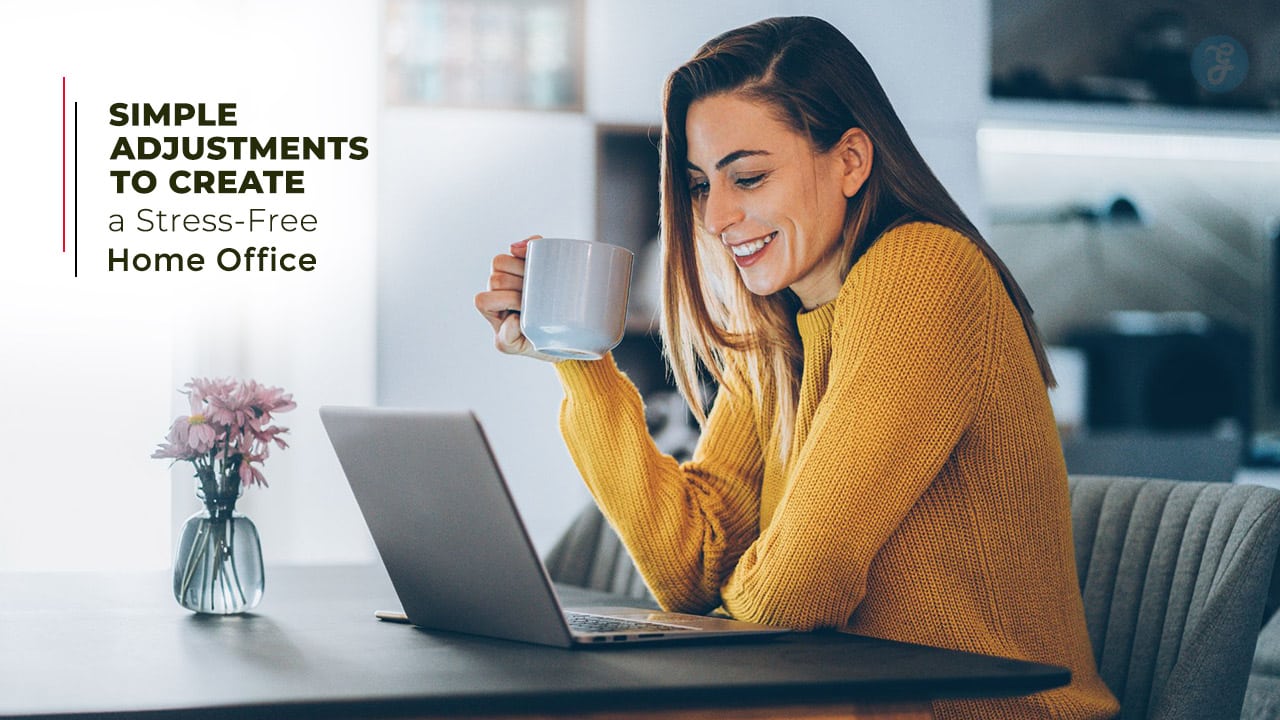Creating a stress-free home office is no longer a luxury—it’s a necessity in today’s remote and hybrid work environments. A well-designed workspace can improve productivity, enhance focus, and positively impact your mental health.
Whether you’re dealing with a cluttered desk, poor lighting, or constant noise distractions, a few simple adjustments can transform your home office into a haven of calm and efficiency.
By focusing on ergonomics, organization, and personalization, you can create a space that not only looks great but also supports your physical and mental well-being.
Why a Stress-Free Home Office Matters?
Your environment directly affects your performance. Research shows that cluttered and poorly organized spaces lead to lower productivity and increased stress levels. A stress-free home office fosters focus, helping you complete tasks efficiently and with minimal frustration. A study by Harvard Business Review highlights that employees in organized environments are 30% more productive than those in cluttered spaces.
Mental Health Benefits of a Calming Home Office
A serene workspace isn’t just about aesthetics. It promotes mental well-being by reducing anxiety, fostering creativity, and making the workday feel less daunting. For example, integrating natural elements, such as plants and sunlight, has been shown to reduce stress and boost happiness. The Global Workplace Wellness Report emphasizes the importance of workplace design in mitigating mental health issues.
How a Stress-Free Setup Saves Time and Energy
When your workspace is organized and optimized, you spend less time searching for documents, untangling cables, or dealing with distractions. A stress-free home office streamlines your workflow, allowing you to achieve more with less effort. According to the American Psychological Association, eliminating time-wasters can boost efficiency by up to 20%.
10 Adjustments to Transform Your Workspace
Having a stress-free home office involves thoughtful planning and minor but impactful changes. Each adjustment you make contributes to a calmer, more functional workspace.
1. Choose Ergonomic Furniture for Comfort
An ergonomic setup is the foundation of a stress-free home office. Poor posture can lead to physical discomfort, making it harder to concentrate and stay productive.
- Why Ergonomics Are Essential for a Stress-Free Home Office: Ergonomic furniture reduces strain on your back, neck, and wrists, ensuring long-term comfort. This prevents common issues like repetitive strain injuries and lower back pain.
- Examples:
- Adjustable standing desks that let you alternate between sitting and standing.
- Chairs with adjustable height, armrests, and lumbar support.
- Accessories like wrist rests for keyboards and footrests for added comfort.
| Ergonomic Furniture | Key Benefits | Price Range |
| Standing Desk | Reduces sitting time, improves circulation | $200 – $700 |
| Ergonomic Chair | Supports posture, prevents back pain | $150 – $600 |
| Wrist Rest | Reduces wrist strain during typing | $10 – $50 |
2. Declutter Your Workspace for Clarity
A clutter-free space equals a clutter-free mind. Begin by removing non-essential items and organizing your work tools. Decluttering improves mental clarity and reduces the time wasted searching for items.
- The Psychology of Decluttering: Studies show that a tidy environment lowers cortisol (stress hormone) levels and boosts mental clarity. Marie Kondo’s tidying method, for example, emphasizes keeping only items that “spark joy.”
- Tips:
- Use labeled storage bins, trays, and drawer organizers to keep everything in its place.
- Implement a “one in, one out” rule to prevent clutter from building up again.
| Decluttering Tool | Purpose | Cost Range |
| Desk Organizer | Keeps supplies organized | $15 – $50 |
| Cable Management | Reduces cable clutter | $10 – $30 |
| Storage Bins | Stores non-essential items | $20 – $100 |
3. Use Calming Colors to Create a Relaxing Environment
Color has a powerful psychological impact, influencing mood and focus. The right colors can create a calming, inspiring atmosphere.
- Best Colors for a Stress-Free Home Office: Opt for soothing tones like blue, green, and beige. These colors promote relaxation and focus. Avoid overly bright or distracting colors like red or neon shades.
- Table: Suggested Color Schemes:
| Color | Mood Impact | Suggested Use |
| Blue | Calm and Focused | Wall paint, accessories |
| Green | Refreshing and Relaxing | Plants, desk items |
| Beige/Neutral | Cozy and Grounding | Furniture, background decor |
4. Optimize Lighting for Productivity
Good lighting reduces eye strain and boosts energy levels, creating a more inviting workspace. Inadequate lighting can lead to fatigue, headaches, and reduced focus.
- The Importance of Natural Light: Position your desk near a window to take advantage of natural light. Studies show natural light improves mood and regulates circadian rhythms.
- Tips:
- Use adjustable desk lamps with daylight bulbs to mimic natural light.
- Add task lighting for specific areas like your desk or reading nook.
| Lighting Type | Benefit | Example Cost |
| Natural Light | Boosts mood and focus | Free |
| Desk Lamps | Reduces eye strain | $20 – $100 |
| Daylight Bulbs | Mimics natural light | $5 – $20 per bulb |
5. Add Greenery to Enhance Your Mood
Plants are one of the simplest ways to bring life to a home office. They provide numerous benefits, including improved air quality and stress reduction.
- Benefits of Plants in a Home Office: Beyond their aesthetic appeal, plants can reduce noise levels and increase oxygen levels, creating a healthier workspace.
- Suggestions for Low-Maintenance Plants:
- Snake plant: Hardy and requires minimal watering.
- Peace lily: Great for low-light conditions.
- Pothos: Thrives in almost any environment.
| Plant | Benefit | Maintenance Level |
| Snake Plant | Improves air quality | Low |
| Peace Lily | Removes toxins, easy care | Low |
| Pothos | Grows well in low light | Low |
6. Minimize Noise for Better Focus
A quiet environment is essential for a stress-free home office, especially if your household is noisy. Noise distractions can significantly hinder productivity.
- Soundproofing Tips for a Stress-Free Home Office:
- Install thick rugs and curtains to absorb noise.
- Use noise-canceling headphones for immediate relief.
- Add acoustic panels to walls for better sound insulation.
| Noise Reduction Tool | Purpose | Price Range |
| Noise-Canceling Headphones | Blocks external noise | $50 – $300 |
| Acoustic Panels | Reduces sound echoes | $30 – $200 |
| Thick Curtains | Absorbs noise | $40 – $150 |
7. Keep Technology Organized and Functional
A messy tangle of cables and poorly placed devices can disrupt your workflow. Organized technology enhances efficiency and aesthetics.
- Cable Management Tips: Use cable clips, zip ties, or under-desk organizers to keep wires neat. Wireless devices further reduce cable clutter.
- Ensure your devices are updated and in working condition to avoid unnecessary stress during your workday.
| Technology Tool | Purpose | Price Range |
| Cable Clips | Organizes loose cables | $5 – $20 |
| Wireless Devices | Reduces cable clutter | $30 – $150 |
| Under-Desk Organizer | Hides cables | $20 – $50 |
8. Incorporate Personal Touches to Boost Comfort
Adding personal elements makes your workspace more inviting and enjoyable. Personalization boosts your emotional connection to the space.
- Examples:
- Display family photos or souvenirs from memorable trips.
- Use motivational quotes as wall art.
- Add a favorite piece of decor that sparks joy.
9. Create Clear Boundaries Between Work and Personal Life
Defining boundaries is critical for maintaining a stress-free home office. Without clear divisions, it’s easy to feel overwhelmed.
- The Role of Dedicated Work Zones: Separate work areas reduce distractions and help maintain focus. This can be as simple as a desk in a quiet corner or as elaborate as a converted room.
- Tips:
- Use partitions or furniture to create a distinct workspace.
- Stick to a consistent work schedule to avoid burnout.
10. Practice Daily Maintenance for Long-Term Serenity
Regular upkeep ensures your home office remains a stress-free zone.
- Quick Maintenance Checklist:
- Clear your desk at the end of each day.
- Wipe down surfaces weekly to keep things fresh.
- Periodically evaluate your setup to ensure it still meets your needs.
Takeaways
A stress-free home office isn’t just about aesthetics—it’s about creating a functional, calming space where you can thrive. By implementing these 10 simple adjustments, you can transform your workspace into a haven of productivity and tranquility. Start small, experiment with what works best for you, and enjoy the benefits of a stress-free home office every day.
Take the first step today and watch your work-from-home experience improve dramatically!




































